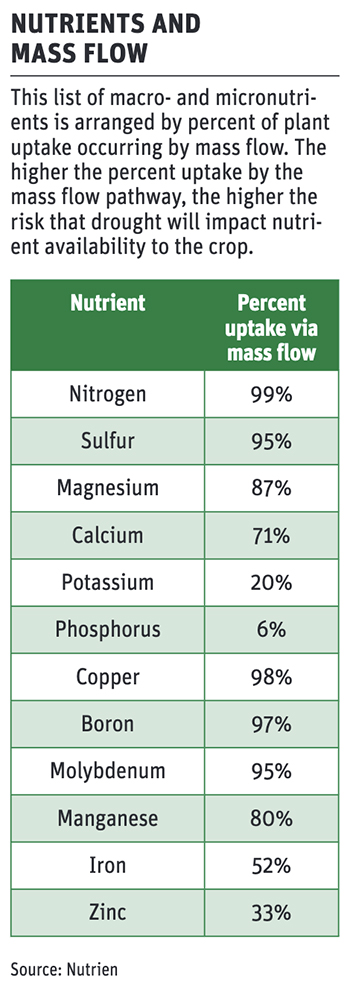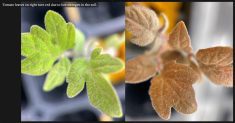The direct damage from drought is obvious, but the real hurt might lie deeper in the soil and affect next year’s crop
The crop-killing drought that’s hanging prairie crops out to dry will have an impact on residual nutrients this fall. What can producers expect to see in their soil tests?
That’s the question probed by Karl Wyant, agronomy director at Nutrien. In a phone interview, Wyant said there are several effects that growers may notice on their soil test results.
He added that, although growers are powerless to halt a drought, there are things they can do to help mitigate the impact. But it depends on whether we’re dealing with a flash drought or an extended dry period like the Great Plains have been experiencing for the past 20 years.
“Here’s what a flash drought looks like. Today as we speak (July 12) over 98 percent of Illinois farmland is under drought. In May, when they were planting, there were no drought conditions at all. That’s how quickly it can happen. Up in your prairie provinces things were looking pretty good in March and April, but that didn’t last long,” said Wyant, adding that soil management is the key.
“But you can improve your soil structure so roots go deeper. Use your soil to store moisture for those dry years. Out in the field I see that folks who’ve been taking these soil health measures have not been hit as severely.”
Wyant is emphatic that snow management is essential. Capturing as much snow as possible gets spring-planted crops off to a good start. But then you need to get rain on the back end. Snow melt won’t see you through the growing season.
Soil surfactants and conditioners help make better use of irrigation water, said Wyant. They obviously don’t make it rain, but they do make better use of any water that does fall on the field.
“If you have irrigation, you don’t want to see water ponding on your fields. Those ponds turn into great big magnifying glasses. They concentrate the sun’s light and heat, and push soil temperatures up toward 175 degrees and hotter.
“Soil particles naturally repel water. Some soils become so dry they lose the ability to take on water. A surfactant can reverse that action so soil absorbs water. Another product is known as soil conditioners. These help re-aggregate the soil and open up more pores so water infiltrates better.
“There are a number of soil surfactants on the market now. They talk about relieving drought stress on the crop. Farmers run them through the irrigation system. They help get more water down into the ground so moisture is stored in the soil instead of letting it pond on the fields.”
Wyant says nutrients get into the crop roots in three ways — mass flow, diffusion and root interception — but mass flow is the biggest factor in understanding nutrient uptake in drought conditions.
Wyant recently talked about nutrient uptake on episode 17 of the Nutrien-sponsored podcast The Dirt: Defining, monitoring and preparing for drought conditions. The following information was gleaned from that podcast.
Aside from the obvious impact of hot, dry conditions, drought also has an influence on the ability of the crop to uptake nutrients. The podcast deals with how drought has a negative impact on specific nutrients because of the nature of their uptake mechanism.
“Root interception is the easiest thing to explain. A root bumps into a nutrient and bam, takes it up.
“Mass flow is nutrient attached to the water while the water flows toward the roots and gets pulled up into the plant. In corn, for example, 99 percent of nitrogen uptake is with mass flow. And in sulfur or sulfate, 95 percent enters the plant through mass flow.”
Wyant said there’s a moisture gradient or moisture discrepancy between the wet soil and the stalk of the plant. The stalk is like a void, and nature abhors a void, so water moves up to fill that void. As the plant continues to grow taller, it continues to grow more void for the soil water to fill. If the soil moisture isn’t there to travel up into the void, then mass flow is in trouble and the plant won’t grow.
The textbook definition stated that mass flow is the movement of nutrients carried by the flow of water from bulk soil to plant roots. As the crop pulls water from the soil to drive photosynthesis and other biological processes, this sets up a natural movement of water from the bulk soil to the root zone, carrying nutrients with it.
With this much dependence on soil water prior to acquiring the nutrient, it’s easy to see how hot, dry conditions have a negative impact on nutrient uptake and subsequent yield.
However, not all nutrients are affected the same. Agronomists like Wyant can predict the impact of drought on nutrient uptake by ranking them according to the proportion influenced by mass flow.
Outside of moisture-stress itself, drought can have a major impact on crop nutrition, especially at the soil surface. Those roots are not as effective at taking up nutrients. So the moisture-stress is compounded with nutrient stress. If there are no nutrients in the subsoil, the crop may experience a variety of nutrient deficiencies.

Which nutrients are most impacted? The table shows that many macronutrients and micronutrients can be impacted by drought due to the dominance of mass flow as the primary crop uptake mechanism. Nitrogen, sulfur and magnesium are macronutrients susceptible to drought induced deficiency. Most of the nutrient is brought into the root system via mass flow.
On the micronutrient side, copper, boron, molybdenum and manganese also have a crop uptake mechanism dependent on mass flow. In contrast, phosphorus, iron and zinc are nutrients that are not as dependent on the flow of water through the soil to drive crop uptake.
The table depicts percent of plant uptake by mass flow in macronutrients and micronutrients. The higher the percent uptake by the mass flow pathway, the higher the risk.
There are several effects growers may notice on their soil test results following a drought. Where crops originally intended as grain are diverted to forage, harvesting the whole plant increases the amount of nutrients removed from the soil.
For example, potassium is mostly present in the leaves and stems of a wheat crop. Removing the whole plant removes more potassium from the system. This may increase potassium deficiencies in subsequent crops if the nutrients are not added back to the soil.
On the other hand, if a low-yielding wheat crop is harvested, residual nutrients remain in the soil. If the crop was fertilized for a higher yield than what was achieved, the remaining fertilizer will likely show up in the soil test, showing higher nutrient levels due to residual fertilizer. These residual nutrients become part of next year’s nutrient budget.
Residual nutrient levels are particularly noticeable in soil-nitrate levels. There may be a significant amount of nitrogen left in the soil that could be used by the following crop, particularly in Western Canada where there is not a lot of over-winter nitrogen loss.
Potassium may still be in the plant tissue but will not show up in a soil test, particularly in dry conditions at the end of the season and post-harvest. We see lower than expected potassium levels because we are not getting the nutrient recycling as rapidly.
Both nutrient removal and residual nutrient rates should be monitored and accounted for when finalizing next year’s nutrient management plan.
















